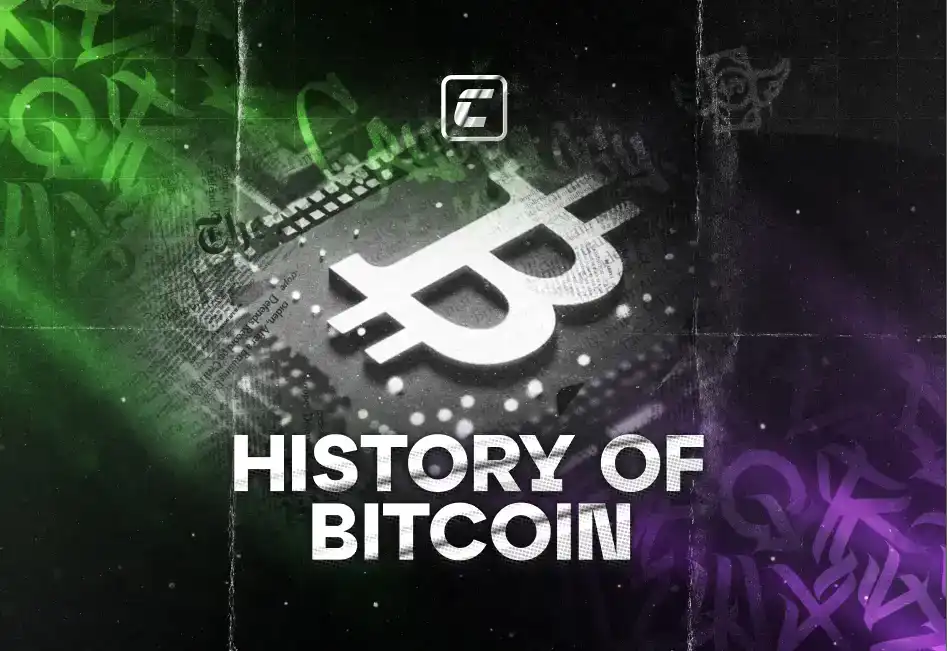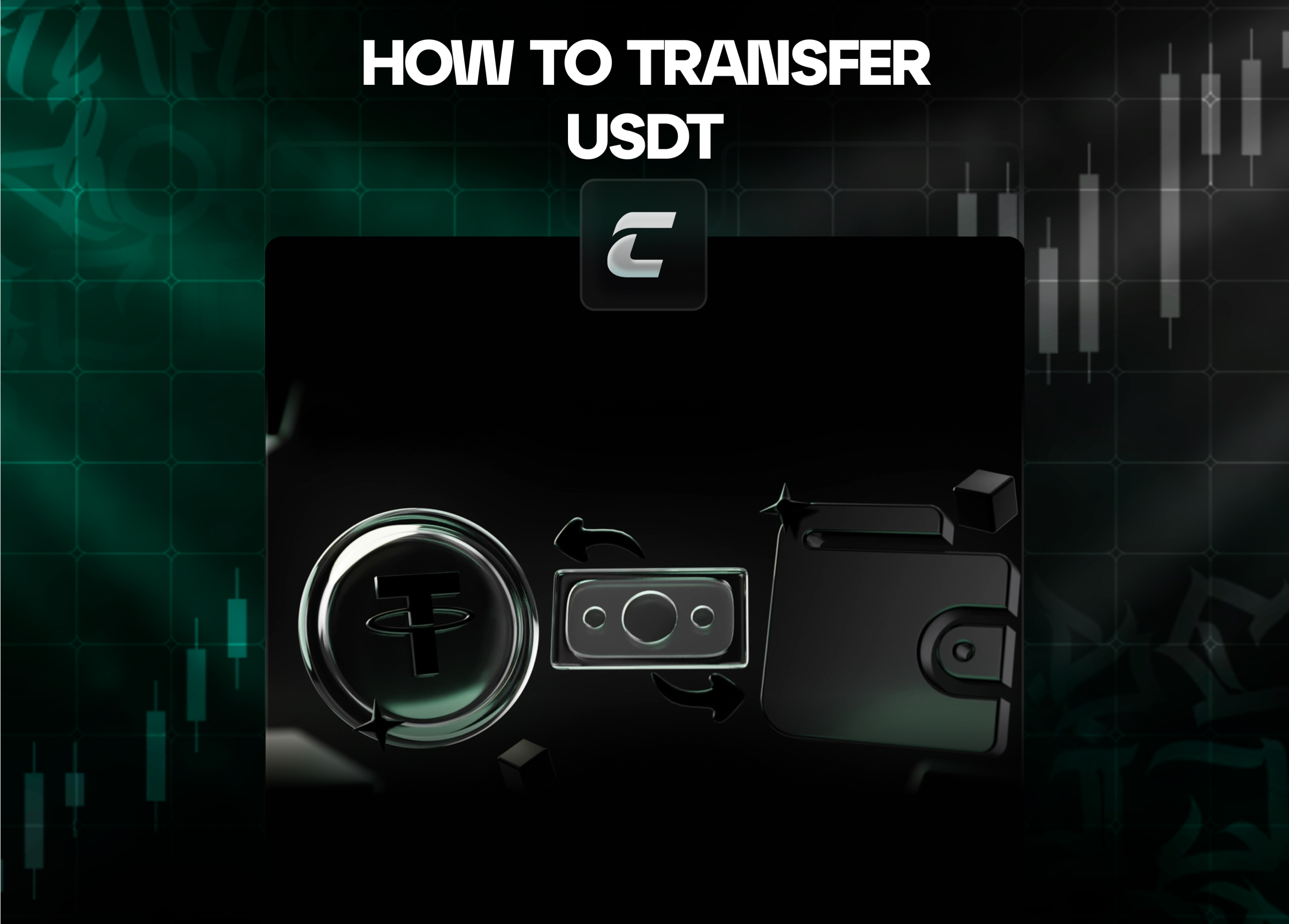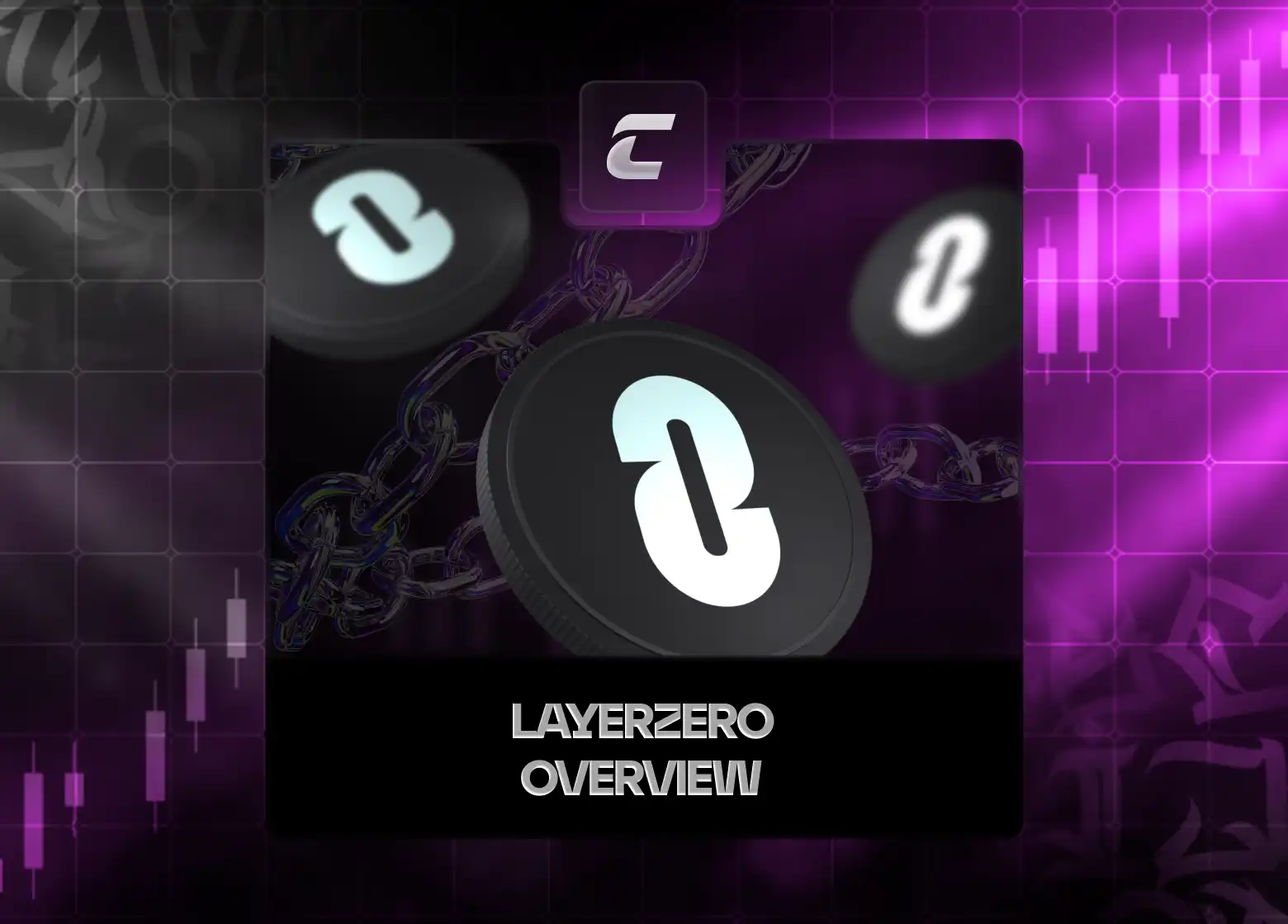
Краткая история экосистемы Polkadot
Экосистема Polkadot - это относительно новое дополнение к технологии блокчейн. Она была основана Гэвином Вудом, который являлся соучредителем Ethereum. Вуд покинул Ethereum в 2016 году, чтобы основать компанию Parity Technologies, которая разработала Polkadot.
Сеть Polkadot была официально запущена в мае 2020 года, и с тех пор быстро завоевала популярность в сообществе блокчейн.

Технология в основе экосистемы Polkadot
Экосистема Polkadot построена на уникальной технологии под названием "релейная цепочка". По сути, это главная цепь, которая соединяет все различные "парачейны" в сети. Парачейны - это отдельные блокчейны, работающие параллельно друг другу и ретрансляционной цепи. Они могут быть настроены для различных целей, например, для обработки определенных типов транзакций или приложений.
Одним из ключевых преимуществ технологии Polkadot является ее способность масштабироваться. Благодаря возможности параллельной работы нескольких парачейнов, сеть может обрабатывать гораздо больший объем транзакций, чем традиционные блокчейны. Кроме того, экосистема Polkadot разработана таким образом, чтобы быть совместимой с другими блокчейнами, то есть она может взаимодействовать с другими сетями и передавать им данные.
Как работает Polkadot?
Polkadot — это инновационная мультичейн-платформа, созданная для обеспечения взаимодействия и масштабирования блокчейнов. Основой Polkadot является Relay Chain, центральная цепь, обеспечивающая безопасность и консенсус всей сети. Парачейны, подключаемые к Relay Chain, могут иметь уникальные функции и токены, обогащая экосистему разнообразными возможностями использования. Механизм Cross-Chain Message Passing (XCMP) позволяет парачейнам обмениваться данными и транзакциями, способствуя интероперабельности и сотрудничеству между различными блокчейнами.
Polkadot использует механизм консенсуса Nominated Proof-of-Stake (NPoS), который позволяет пользователям выбирать валидаторов для поддержания сети, способствуя децентрализации и эффективности. Эта платформа решает проблемы масштабируемости и взаимодействия блокчейнов, предлагая рамки для создания и интеграции разнообразных блокчейнов. Такой подход открывает новые возможности для разработчиков и предприятий, стремящихся к инновациям в области блокчейн, делая технологию более доступной, гибкой и мощной для различных приложений.

Polkadot: фонды и частные инвесторы
Экосистема Polkadot привлекла значительные инвестиции как от институциональных фондов, так и от индивидуальных инвесторов.
- Одним из ярких примеров является Polkadot Ecosystem Fund, который был запущен в 2019 году с целью поддержки проектов в рамках экосистемы Polkadot. Фонд привлек более 200 миллионов долларов от таких инвесторов, как Polychain Capital, Coinbase Ventures и Digital Currency Group.
- В 2020 году токен Polkadot (DOT) был размещен на крупнейших криптовалютных биржах, таких как Binance и Kraken, и быстро стал одной из самых высокодоходных криптовалют.
Дорожная карта
- 2016 - Компания Parity Technologies основана доктором Гэвином Вудом, соучредителем Ethereum.
- 2017 - Начинается разработка сети Polkadot с упором на создание уникальной архитектуры, обеспечивающей совместимость между различными блокчейнами.
- 2018 - Выпущен фреймворк для разработки блокчейна Substrate, который позволяет разработчикам легко создавать собственные блокчейны, которые могут быть интегрированы с Polkadot.
- 2019 - Запущен Фонд экосистемы Polkadot, целью которого является поддержка проектов в рамках экосистемы Polkadot. Фонд привлекает более 200 миллионов долларов от инвесторов.
- 2020 (май) - Официальный запуск сети Polkadot с выпуском первой версии программного обеспечения Polkadot.
- 2020 (август) - Запущена первая версия тестовой сети Polkadot, позволяющая разработчикам экспериментировать с сетью и выявлять любые потенциальные проблемы.
- 2020 (ноябрь) - Первый проект на базе Polkadot, децентрализованная финансовая платформа Acala, привлекает 7 миллионов долларов в рамках seed-раунда финансирования.
- 2021 (январь) - Собственный токен Polkadot, DOT, размещен на крупнейших криптовалютных биржах, таких как Binance и Kraken.
- 2022 (май) - Сеть Polkadot подвергается крупному обновлению, известному как "Polkadot 2.0", которое включает новые функции, такие как управление на цепи и улучшенная масштабируемость.
- 2023 - Команда Polkadot продолжает работать над расширением сети и внедрением новых функций, таких как запуск парачейнов через серию аукционов.
Социальная активность и комьюнити экосистемы Polkadot
Polkadot - это быстро развивающаяся сеть, которая привлекла большое и активное сообщество разработчиков, инвесторов и энтузиастов. Сообщество очень активно, для тех, кто хочет узнать больше о проекте, доступно множество ресурсов.
Одним из лучших ресурсов для тех, кто хочет быть в курсе последних событий в экосистеме Polkadot, является официальный блог Polkadot. В блоге регулярно публикуются обновления от команды Polkadot, а также новости и аналитические материалы из независимых источников.
Еще одним популярным ресурсом является сабреддит Polkadot, который насчитывает более 40 000 участников. Сабреддит является центром обсуждения новостей, событий и проектов, связанных с Polkadot. Сообщество очень активно, здесь часто появляются сообщения о новых проектах и инициативах, которые разрабатываются в экосистеме.
В дополнение к этим ресурсам существует множество СМИ, ориентированных на Polkadot, и подкастов, посвященных освещению последних новостей и событий в экосистеме. Некоторые из них - Polkadot Digest, Polkadot News и Polkadot Pulse.


Обзор экосистемы Polkadot
Экосистема Polkadot – это современная и масштабируемая сеть блокчейнов, созданная для улучшения взаимодействия и сотрудничества между различными блокчейнами. Кроме того, Polkadot является защищенной и расширяемой платформой для разработки децентрализованных приложений (dApps) и блокчейн-систем, используя среду Substrate для их создания.
Polkadot выделяется на рынке своим уникальным подходом к решению основных проблем отрасли. Эта платформа предоставляет продвинутое и эффективное решение для взаимодействия разных блокчейнов, облегчая их взаимную совместимость и обмен информацией.
Основной его целью является обеспечение интероперабельности между различными блокчейнами. Как правило, каждый блокчейн работает изолированно со своими уникальными характеристиками и протоколами, в то время, как Polkadot стремится создать универсальный мост, который позволит этим разнообразным системам взаимодействовать и обмениваться данными.
Еще одной важной задачей Polkadot является повышение масштабируемости блокчейнов. С ростом популярности и использования блокчейн-технологий становится критически важным увеличение их пропускной способности. Polkadot решает эту проблему через механизм параллельных цепочек, или парачейнов, которые позволяют обрабатывать большое количество транзакций одновременно, тем самым значительно повышая эффективность сети.
Основные элементы этой экосистемы включают:
- Ретрансляционная цепочка (Relay Chain): ядро экосистемы Polkadot. Это основная блокчейн-сеть, которая обеспечивает безопасность и интероперабельность всей системы. Ретрансляционная цепочка координирует систему, управляет сетью и обеспечивает консенсус между различными блокчейнами.
- Парачейны (Parachains): это независимые блокчейны с уникальным токеном и индивидуальными правилами сети. Для того, чтобы функционировать как парачейн в сети Polkadot, блокчейнам обычно необходимо арендовать место. Они подключаются к ретрансляционной цепочке и используют ее для обеспечения безопасности и межсетевого взаимодействия. Парачейны могут функционировать автономно, но при этом способны обмениваться данными и взаимодействовать друг с другом. Эта особенность делает Polkadot уникальным, так как она решает проблему изоляции блокчейнов, которые ранее не могли эффективно взаимодействовать. При этом парачейны могут быть разработаны для различных целей и приложений, от DeFi до игр и социальных сетей.
- Parathreads: это похоже на парачейны, но с более гибкой и экономичной моделью подключения. Они предназначены для блокчейнов, которым не требуется постоянное подключение к ретрансляционной цепочке. Parathreads идеально подходят для проектов с меньшей активностью или для тех, кто не хочет платить за постоянное место в сети.
- Мосты: это специальные парачейны или parathreads, которые позволяют Polkadot взаимодействовать с другими блокчейнами, такими как Ethereum или Bitcoin. Они позволяют передавать токены и другую информацию между разными сетями, расширяя возможности и функциональность Polkadot.
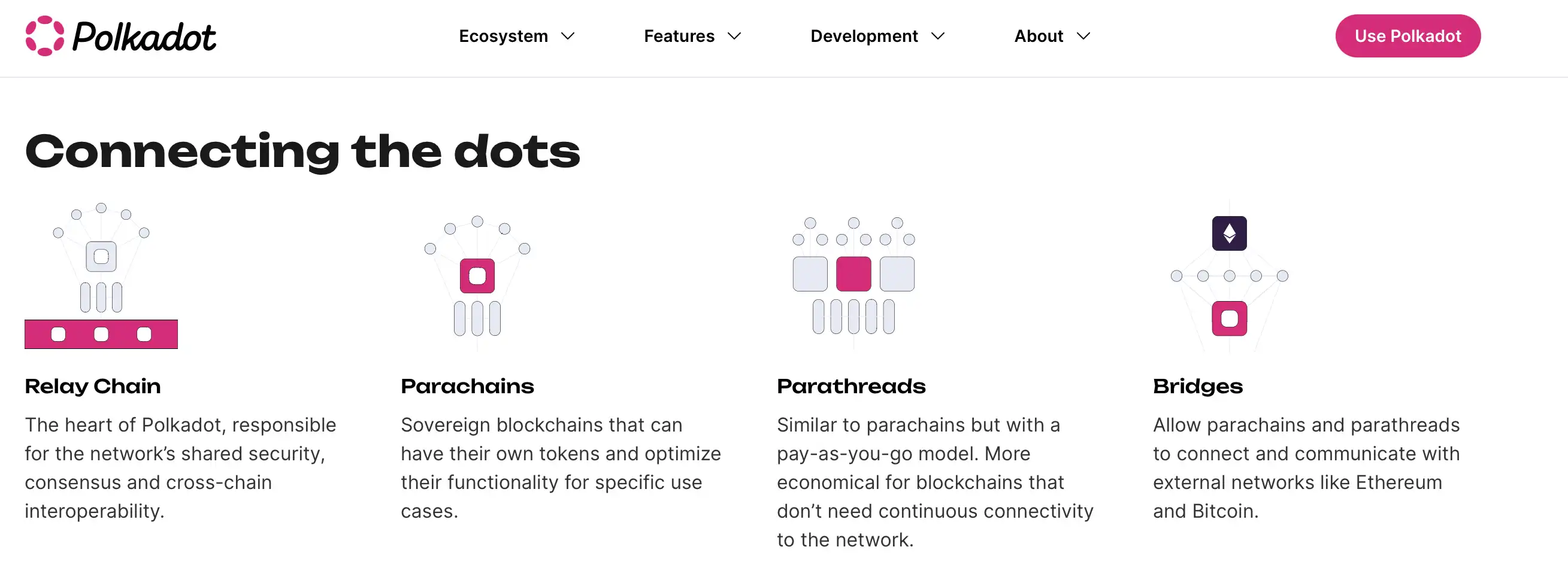
Polkadot был создан для того, чтобы устранить ограничения отдельных блокчейнов, создав общедоступную, масштабируемую и безопасную межблокчейновую экосистему, которая сочетает разнообразные технологии и приложения в единой экосистеме. Благодаря этим особенностям, сеть Polkadot превратилась в активно растущую экосистему, привлекающую множество новых проектов.
Преимущества монет экосистемы Polkadot
Благодаря инновационным особенностям сети Polkadot, монеты этой экосистемы имеют заметные преимущества:
- Интероперабельность: монеты в экосистеме Polkadot могут легко перемещаться и взаимодействовать между различными блокчейнами внутри сети. Это обеспечивает высокую степень гибкости и открывает новые возможности для транзакций и интеграции различных приложений.
- Масштабируемость: благодаря структуре Polkadot, которая распределяет нагрузку по множеству параллельных цепочек, транзакции с монетами могут обрабатываться быстрее и эффективнее, чем в традиционных блокчейнах. Это способствует более высокой пропускной способности и уменьшению задержек.
- Улучшенная безопасность: в экосистеме Polkadot безопасность является одним из ключевых аспектов. В Polkadot все парачейны разделяют общую безопасность, предоставляемую ретрансляционной цепочкой. Это означает, что даже меньшие блокчейны в сети защищены на уровне всей сети, что значительно повышает их устойчивость к атакам. Кроме того, Polkadot использует передовые алгоритмы консенсуса, которые обеспечивают надежность и целостность всей сети.

- Инновационный Центр: Polkadot постоянно внедряет новые технологии и концепции, такие как парачейны и мосты, что способствует развитию всей индустрии. В Polkadot существует фреймворк Substrate, благодаря которому Polkadot предлагает удобную платформу для создания и тестирования новых блокчейн-приложений.
- Диверсификация: вкладывая в экосистему Polkadot инвестор может разнообразить свои инвестиции. В Polkadot разрабатываются проекты самых разных направлений, от DeFi до социальных сетей и идентификации.
ТОП монет экосистемы Polkadot
DOT – основной токен экосистемы Polkadot, он играет центральную роль в ее функционировании и управлении.
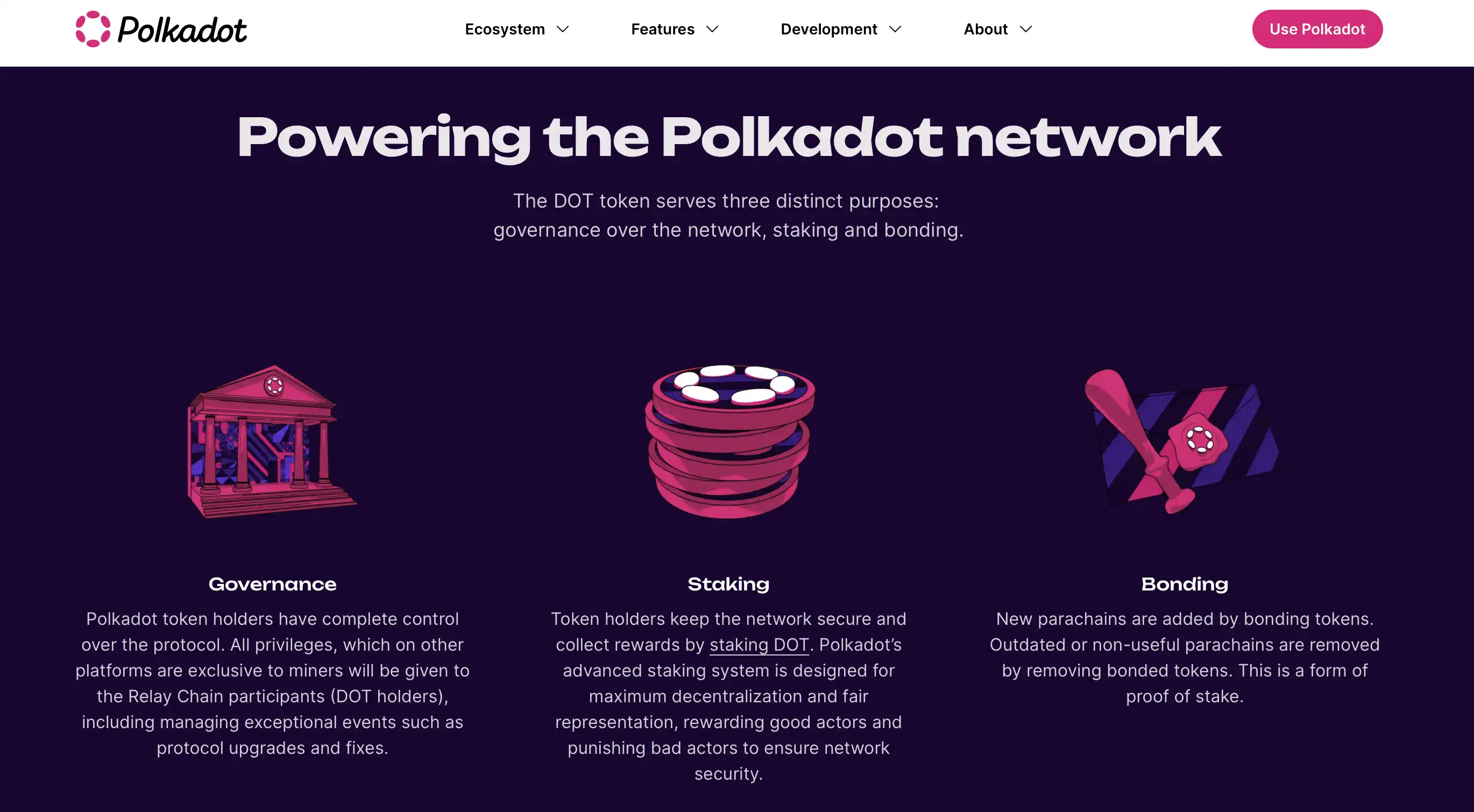
Рыночная капитализация DOT составляет $12,8 млрд.
Важность токена: токен DOT играет центральную роль в экосистеме Polkadot, являясь ключевым элементом, который обеспечивает ее функционирование и развитие. Он упрощает проведение транзакций, вносит вклад в безопасность сети через стейкинг и участвует в управлении, позволяя владельцам DOT быть активными участниками в процессе принятия решений.
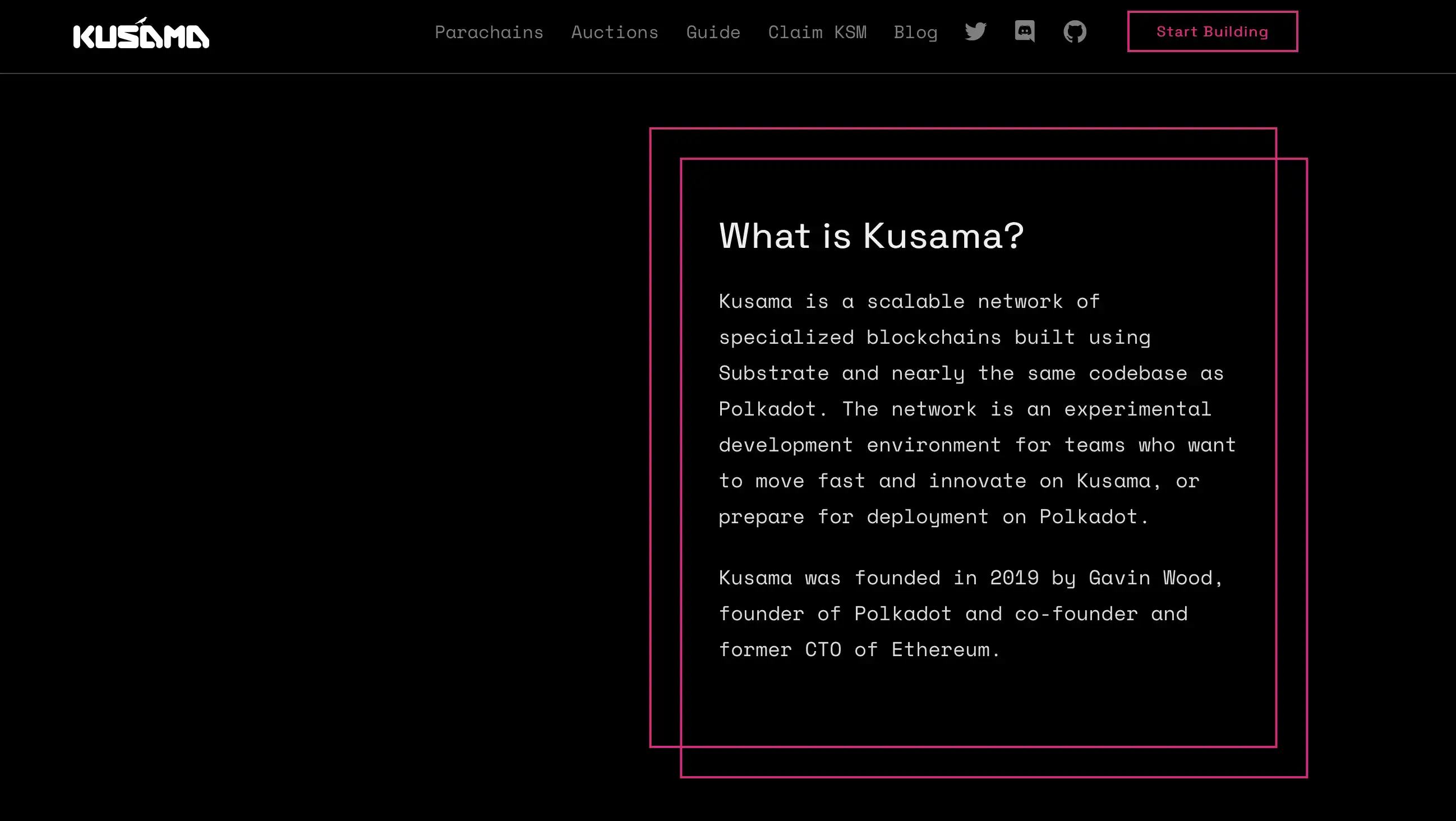
Kusama (KSM)
Рыночная капитализация KSM составляет $516,884,650.
Важность токена: Kusama играет уникальную роль в экосистеме Polkadot, представляя собой нечто вроде "тестовой сети" или "экспериментальной площадки" для разработчиков. Kusama предлагает более быстрый и гибкий процесс разработки и тестирования по сравнению с Polkadot. Это позволяет разработчикам испытывать новые идеи, технологии и инновации в условиях, максимально приближенных к реальным.
Chainlink (LINK)
Рыночная капитализация LINK составляет $10,105,139,541.
Важность токена: Chainlink играет чрезвычайно важную роль в блокчейн-экосистеме, предоставляя критически важный сервис в виде децентрализованных оракулов. Оракулы — это посредники, которые связывают блокчейны с внешним миром, обеспечивая взаимодействие смарт-контрактов с данными и системами за пределами их собственной сети. С помощью Chainlink смарт-контракты могут автоматически выполнять операции на основе данных из внешнего мира, что открывает новые возможности для DeFi на Polkadot.

Moonbeam (GLMR)
Рыночная капитализация GLMR составляет $414,159,727.
Важность токена: Moonbeam представляет собой значимую составляющую экосистемы Polkadot, благодаря своей уникальной способности упростить интеграцию и сотрудничество между блокчейном Polkadot и Ethereum.
Moonbeam разработан для обеспечения высокой степени совместимости с Ethereum. Это означает, что разработчики, знакомые с Ethereum и Solidity (языком программирования Ethereum), могут легко переносить свои приложения в экосистему Polkadot, используя Moonbeam. Таким образом, Moonbeam действует как мост между двумя ведущими блокчейн-платформами.

Acala (ACA)
Рыночная капитализация ACA составляет $175,441,461.
Важность токена: Acala является центральным хабом для DeFi в экосистеме Polkadot. Acala – это децентрализованная финансовая платформа (DeFi), которая работает на блокчейне Polkadot. Acala предлагает два DEX, Acala Swap и Acala Pro. Acala Swap – это простой и удобный DEX, который позволяет пользователям обменивать токены без необходимости регистрироваться или проходить KYC.
Acala Pro – это более продвинутый DEX, который предлагает более широкий спектр функций и возможностей. Кроме того, Acala предлагает различные депозитные пулы, которые позволяют пользователям получать проценты на свои токены. Acala также предлагает кредитную платформу, которая позволяет пользователям занимать и предоставлять кредиты. Кредиты предоставляются в виде токенов ACA, которые могут использоваться для оплаты товаров и услуг в экосистеме Polkadot.
Токеномика
Сеть Polkadot имеет модель токеномики, которая разработана для стимулирования участия и обеспечения стабильности сети. Родной токен сети называется DOT, он используется для обеспечения безопасности сети, участия в управлении цепочкой и оплаты транзакций.
- Одна из ключевых особенностей - механизм стейкинга, который позволяет владельцам DOT участвовать в работе сети и получать вознаграждения. Чтобы стать валидатором, владельцы DOT должны заблокировать определенное количество своих токенов как залог. Валидаторы отвечают за проверку транзакций и добавление новых блоков в сеть. За свою работу они получают вознаграждение.
- Владельцы DOT могут голосовать за предложения об изменениях в сети, таких как добавление новых функций или внесение изменений в алгоритм консенсуса. Процесс голосования прозрачен и децентрализован, при этом все владельцы DOT имеют равное право голоса в процессе принятия решений.
- Токеномика сети Polkadot также включает в себя сочетание инфляции и дефляции. По мере того, как к сети подключается все больше валидаторов, уровень инфляции снижается, что помогает обеспечить стабильность и безопасность сети. В то же время, часть комиссионных за транзакции сжигается, что помогает уменьшить общее предложение токенов DOT и со временем повысить их стоимость.
В общем токеномика экосистемы Polkadot направлена на поощрение участия и обеспечение долгосрочной стабильности сети. Благодаря уникальным механизмам стейкинга и управления, а также ориентации на контроль инфляции и повышения стоимости, Polkadot позиционирует себя как один из самых перспективных блокчейн-проектов в экосистеме.
Какие функции выполняет токен DOT?
- Управление: DOT дает его владельцам возможность участвовать в управлении сетью Polkadot. Это включает в себя голосование по различным предложениям, касающимся изменений в протоколе, обновлений и улучшений сети. DOT обеспечивает децентрализованное управление, позволяя сообществу напрямую влиять на будущее экосистемы.
- Стейкинг: токены DOT используются для стейкинга, что является ключевым элементом механизма безопасности сети Polkadot. Участники сети, которые замораживают свои токены DOT для стейкинга, помогают обеспечивать сетевой консенсус и защищают сеть от различных атак. Взамен они получают вознаграждения, также выплачиваемые в DOT.
- Создание и удаление парачейнов: DOT используется для процесса связывания (bonding) при добавлении новых парачейнов в сеть Polkadot. Это означает, что для запуска нового парачейна необходимо заблокировать определенное количество DOT. После удаления парачейна из сети эти токены возвращаются их владельцам. Этот процесс обеспечивает экономический стимул для поддержки полезных и надежных парачейнов.
- Экономический стимул: инфляционная модель Polkadot, в которой новые DOT создаются для вознаграждения участников, занимающихся стейкингом, способствует активному участию в экосистеме и поддержанию ее активности.
- Финансирование и поддержка проектов: DOT может использоваться для финансирования проектов в рамках экосистемы Polkadot, включая гранты и краудфандинг, что способствует инновациям и развитию новых технологий.
- Транзакционные комиссии: в Polkadot DOT также используется для оплаты транзакционных комиссий, что является стандартной практикой во многих блокчейн-сетях.
Стейкинг Polkadot
Стейкинг в сети Polkadot представляет собой важный процесс, который способствует поддержанию безопасности и стабильности сети, а также позволяет участникам зарабатывать вознаграждения. Это механизм, который используется в консенсусном алгоритме Polkadot, известном как Nominated Proof of Stake (NPoS).
В Polkadot стейкинг заключается в том, что держатели токенов DOT могут заморозить (или "стейкать") свои монеты, тем самым обеспечивая поддержку работы сети. Эти замороженные монеты используются для выбора валидаторов, которые будут участвовать в процессе создания новых блоков и поддержания безопасности сети.
Участники стейкинга в Polkadot делятся на две основные группы: валидаторы и номинаторы. Валидаторы отвечают за создание новых блоков и поддержание сети. Номинаторы, в свою очередь, выбирают валидаторов, которым они доверяют, и "номинируют" их, замораживая свои DOT в поддержку этих валидаторов.
Система стейкинга в Polkadot спроектирована таким образом, чтобы максимально эффективно распределить стейкинг между валидаторами, обеспечивая тем самым справедливое и безопасное управление сетью. Это также помогает предотвратить централизацию и увеличивает общую безопасность сети.
За свою роль в поддержке сети участники стейкинга получают вознаграждения. Эти вознаграждения выплачиваются в токенах DOT и зависят от нескольких факторов, включая общее количество замороженных токенов и эффективность работы валидаторов.
В целом, стейкинг в Polkadot не только предлагает способ получения пассивного дохода для участников сети, но и является критически важной частью механизма обеспечения ее безопасности и эффективности.
Рыночное состояние
Polkadot занимает сильную позицию на рынке по сравнению со своими основными конкурентами, включая Cardano, Solana и BNB Chain. Имея капитализацию около $13 миллиардов, по состоянию на март 2024 года, Polkadot стабильно входит число 15 крупнейших криптовалютных проектов.
В настоящее время Polkadot считается одной из лучших экосистем на рынке, уделяя особое внимание совместимости и масштабируемости. Она привлекает значительное внимание инвесторов, разработчиков и более широкого криптосообщества благодаря своим инновационным функциям, таким как возможность подключения различных сетей блокчейн.
В целом, положение Polkadot на рынке довольно прочное, и у нее есть потенциал для дальнейшего роста и развития в ближайшие годы.

Конкурентный анализ
Одним из преимуществ Polkadot перед Ethereum является способность подключаться к нескольким блокчейнам. Это позволяет проектам, построенным на Polkadot, быть более совместимыми, чем проекты, построенные на Ethereum, которые ограничены этой сетью.
Еще одним конкурентом экосистемы Polkadot является BNB Chain - это более новая блокчейн-сеть, которая завоевала значительную популярность благодаря низким комиссиям за транзакции и высокой пропускной способности. BSC похожа на Ethereum тем, что позволяет создавать смарт-контракты и dApps.
Заключительные мысли от трейдеров Cryptology KEY об экосистеме Polkadot
Экосистема Polkadot представляет собой одну из самых инновационных и важных разработок в современном мире блокчейна. С её появлением открываются новые горизонты для интероперабельности, масштабируемости и гибкости в области блокчейн-технологий. Основываясь на уникальной концепции парачейнов, Polkadot позволяет различным блокчейнам взаимодействовать друг с другом.
Ключевым преимуществом Polkadot является её способность обеспечивать безопасную и эффективную среду для многообразия проектов, от финансов и страхования до игровой индустрии и социальных медиа.
Polkadot также представляет собой отличную платформу для инноваций благодаря своему подходу к тестированию и разработке новых технологий, в частности, через экосистему Kusama. Это позволяет разработчикам экспериментировать и испытывать новые идеи в реальных условиях, прежде чем внедрять их в основную сеть Polkadot.
Однако, как и в случае с любой развивающейся технологией, будущее Polkadot будет зависеть от ее способности адаптироваться к меняющимся условиям и потребностям пользователя, а также от способности её сообщества поддерживать и развивать эту экосистему.
Что такое Polkadot?
Кто создал Polkadot?
Какова роль токена DOT в экосистеме Polkadot?
Как обеспечивается безопасность в экосистеме Polkadot?
Какие преимущества предоставляет Polkadot по сравнению с другими блокчейнами?

Тогда расскажи друзьям – пусть тоже прокачивают свои навыки. Поделиться можно легко с помощью кнопок внизу или просто скопировав ссылку. Мы будем рады твоим отметкам в соц. сетях!
Поделиться

Подписывайся на нашу email-рассылку и получай свежие аналитические обзоры, новости, инсайты и приглашения на прямые эфиры прямо в свой почтовый ящик. Никакого спама — только ценная информация для трейдеров!



